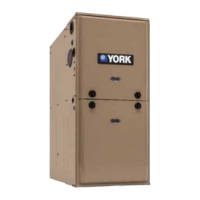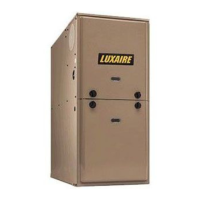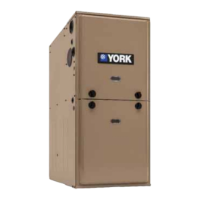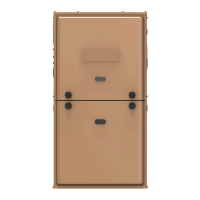5594752-UIM-C-1119
Johnson Controls Ducted Systems 15
Air Supply Openings and Ducts
1. An opening may be used in lieu of a duct to provide the outside air
supply to an appliance unless otherwise permitted by the authority
having jurisdiction. The opening shall be located within 12” (30.5
cm) horizontally from, the burner level of the appliance. Refer to
“COMBUSTION AIR SOURCE FROM OUTDOORS and VENT
AND SUPPLY AIR SAFETY CHECK” in these instructions for addi-
tional information and safety check procedure.
2. The duct shall be either metal, or a material meeting the class 1
requirements of CAN4-S110 Standard for Air Ducts.
3. The duct shall be least the same cross-sectional area as the free
area of the air supply inlet opening to which it connects.
4. The duct shall terminate within 12” (30.5 cm) above, and within 24”
(61 cm) horizontally from, the burner level of the appliance having
the largest input.
5. A square or rectangular shaped duct shall only be used when the
required free area of the supply opening is 9 in
2
(58.06 cm
2
) or
larger. When a square or rectangular duct is used, its small dimen-
sion shall not be less than 3” (7.6 cm).
6. An air inlet supply from outdoors shall be equipped with a means to
prevent the direct entry of rain and wind. Such means shall not
reduce the required free area of the air supply opening.
7. An air supply inlet opening from the outdoors shall be located not
less than 12” (30.5 cm) above the outside grade level.
Combustion Air Source from Outdoors
1. Two permanent openings, one within 12” (30.5 mm) of the top and
one within 12” (30.5 mm) of bottom of the confined space, Two per-
manent openings, shall communicate directly or by means of ducts
with the outdoors, crawl spaces or attic spaces.
2. One permanent openings, commencing within 12” (30.5 cm) of the
top of the enclosure shall be permitted where the equipment has
clearances of at least 1” (2.54 cm) from the sides and back and 6”
(15.24 cm) from the front of the appliance. The opening shall com-
municate directly with the outdoors and shall have a minimum free
area of:
a. 1 in.
2
/ 3,000 BTU/hr (700mm2/kW) of the total input rating of all
equipment located in the enclosure.
b. Not less than the sum of all vent connectors in the confined
space.
3. The duct shall be least the same cross-sectional area as the free
area of the air supply inlet opening to which it connects.
4. The blocking effects of louvers, grilles and screens must be given
consideration in calculating free area. If the free area of a specific
louver or grille is not known. Refer to Table 6 to estimate free area.
Ventilated Combustion Air
The ventilated attic space or a crawl space from which the combustion
air is taken must comply with the requirements specified in “AIR
SOURCE FROM OUTDOORS” in this instruction or in Section 5.3, Air
for Combustion and Ventilation of the National Fuel Gas Code, ANSI
Z223.1 (latest edition). This type installation requires two properly sized
pipes. One brings combustion air from a properly ventilated attic space
or crawl space and a second pipe that extends from the furnace vent
connection (top right of unit) to the exterior of the building.
Vent and Supply (Outside) Air Safety Check Procedure
For Category I furnaces, vent installations shall be in accordance with
Parts 7 and 11 of the National Fuel Gas Code, ANSI Z223.1/NFPA 54,
and or Section 7 and Appendix B of the CSA B149.1, Natural Gas and
Propane Installation Codes, the local building codes, furnace and vent
manufacturer's instructions.
Multi-story or common venting systems are permitted and must be
installed in accordance with the National Fuel Gas Code, ANSI Z223.1/
NFPA 54 and / or the CSA B149.1, Natural Gas and Propane Installa-
tion Codes, local codes, and the manufacture's instructions.
Vent connectors serving Category I furnaces shall not be connected
into any portion of mechanical draft systems operating under positive
pressure.
Horizontal portions of the venting system shall be supported to prevent
sagging using hangers or perforated straps and must slope upwards
not less than 1/4” per foot (21 mm/m) from the furnace to the vent termi-
nal.
It is recommended that you follow the venting safety procedure below.
This procedure is designed to detect an inadequate ventilation system
that can cause the appliances in the area to operate improperly causing
unsafe levels of Carbon Monoxide or an unsafe condition to occur.
FIGURE 17: Ambient Combustion Air
*DEOH
9HQW
*DV
9HQW
6RIILW
9HQW
9HQWLODWHG
$WWLF
7RS$ERYH
,QVXODWLRQ
2SWLRQDO
,QOHWD
2XWOHW
$LUD
9HQWLODWHG
&UDZO6SDFH
*DV
:DWHU
+HDWHU
)XUQDFH
6RIILW
9HQW
*DV
:DWHU
+HDWHU
,QOHW
$LUD
,QOHW
$LUE
)XUQDFH
*DV
9HQW
2XWOHW
$LUD
2XWOHW
$LUE
,QOHW
$LUD
,QOHW
$LUE
*DV
:DWHU
+HDWHU
)XUQDFH
*DEOH
9HQW
*DV
9HQW
9HQWLODWHG
$WWLF
7RS$ERYH
,QVXODWLRQ
$
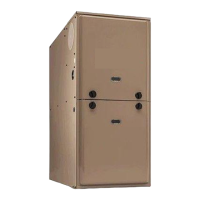
